Holistic Assessment and Planning for a Patient with Suicidal Tendency
VerifiedAdded on 2023/06/09
|10
|2739
|218
AI Summary
This article discusses the case of Jayan, an aboriginal patient with suicidal tendency. It covers the mental status examination, clinical formulation table, nursing care plan, and cultural safety. It also explains the importance of therapeutic relationship and recovery-oriented nursing care. The article provides expert guidance on how to manage a patient with suicidal tendency.
Contribute Materials
Your contribution can guide someone’s learning journey. Share your
documents today.
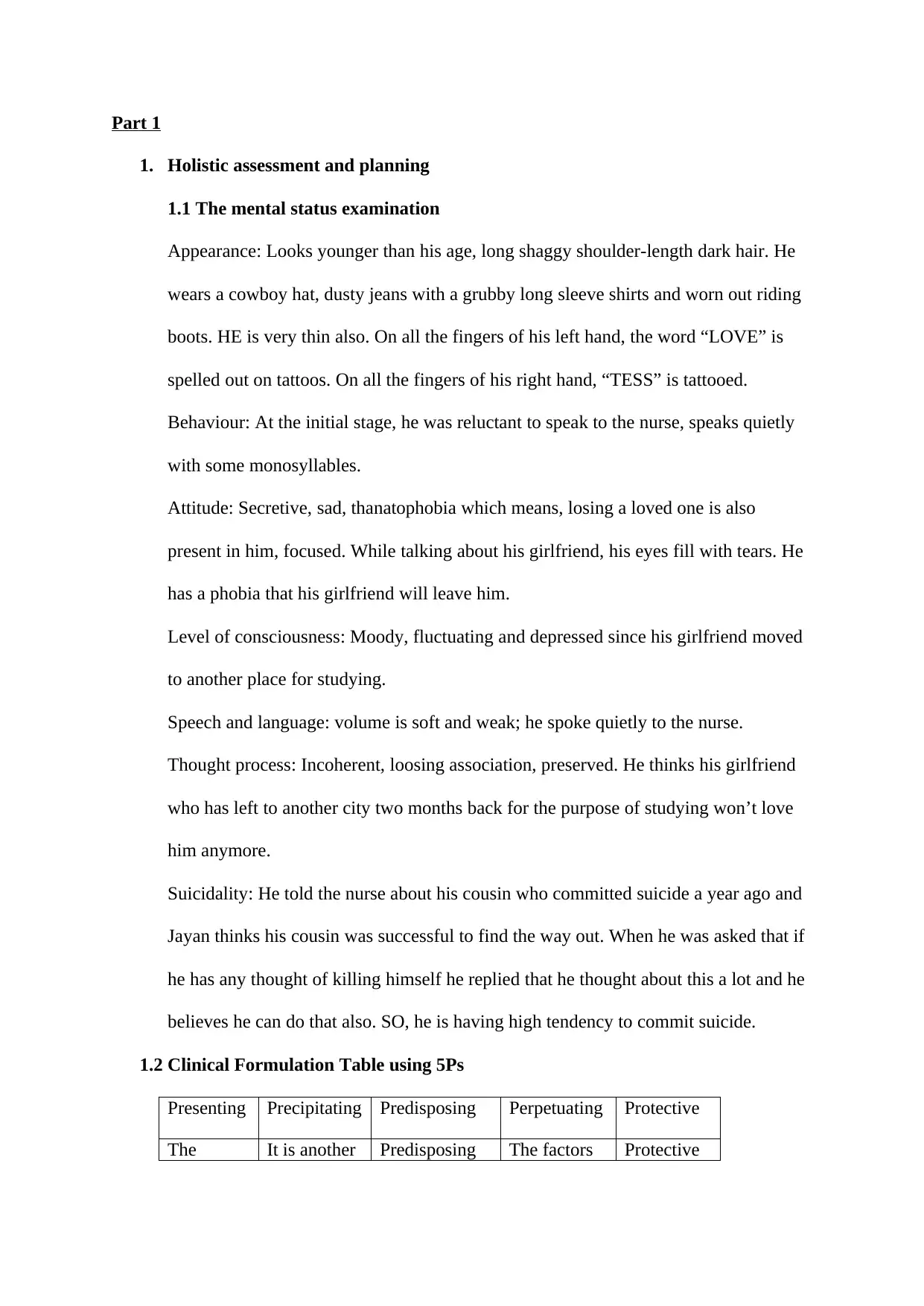
Part 1
1. Holistic assessment and planning
1.1 The mental status examination
Appearance: Looks younger than his age, long shaggy shoulder-length dark hair. He
wears a cowboy hat, dusty jeans with a grubby long sleeve shirts and worn out riding
boots. HE is very thin also. On all the fingers of his left hand, the word “LOVE” is
spelled out on tattoos. On all the fingers of his right hand, “TESS” is tattooed.
Behaviour: At the initial stage, he was reluctant to speak to the nurse, speaks quietly
with some monosyllables.
Attitude: Secretive, sad, thanatophobia which means, losing a loved one is also
present in him, focused. While talking about his girlfriend, his eyes fill with tears. He
has a phobia that his girlfriend will leave him.
Level of consciousness: Moody, fluctuating and depressed since his girlfriend moved
to another place for studying.
Speech and language: volume is soft and weak; he spoke quietly to the nurse.
Thought process: Incoherent, loosing association, preserved. He thinks his girlfriend
who has left to another city two months back for the purpose of studying won’t love
him anymore.
Suicidality: He told the nurse about his cousin who committed suicide a year ago and
Jayan thinks his cousin was successful to find the way out. When he was asked that if
he has any thought of killing himself he replied that he thought about this a lot and he
believes he can do that also. SO, he is having high tendency to commit suicide.
1.2 Clinical Formulation Table using 5Ps
Presenting Precipitating Predisposing Perpetuating Protective
The It is another Predisposing The factors Protective
1. Holistic assessment and planning
1.1 The mental status examination
Appearance: Looks younger than his age, long shaggy shoulder-length dark hair. He
wears a cowboy hat, dusty jeans with a grubby long sleeve shirts and worn out riding
boots. HE is very thin also. On all the fingers of his left hand, the word “LOVE” is
spelled out on tattoos. On all the fingers of his right hand, “TESS” is tattooed.
Behaviour: At the initial stage, he was reluctant to speak to the nurse, speaks quietly
with some monosyllables.
Attitude: Secretive, sad, thanatophobia which means, losing a loved one is also
present in him, focused. While talking about his girlfriend, his eyes fill with tears. He
has a phobia that his girlfriend will leave him.
Level of consciousness: Moody, fluctuating and depressed since his girlfriend moved
to another place for studying.
Speech and language: volume is soft and weak; he spoke quietly to the nurse.
Thought process: Incoherent, loosing association, preserved. He thinks his girlfriend
who has left to another city two months back for the purpose of studying won’t love
him anymore.
Suicidality: He told the nurse about his cousin who committed suicide a year ago and
Jayan thinks his cousin was successful to find the way out. When he was asked that if
he has any thought of killing himself he replied that he thought about this a lot and he
believes he can do that also. SO, he is having high tendency to commit suicide.
1.2 Clinical Formulation Table using 5Ps
Presenting Precipitating Predisposing Perpetuating Protective
The It is another Predisposing The factors Protective
Secure Best Marks with AI Grader
Need help grading? Try our AI Grader for instant feedback on your assignments.
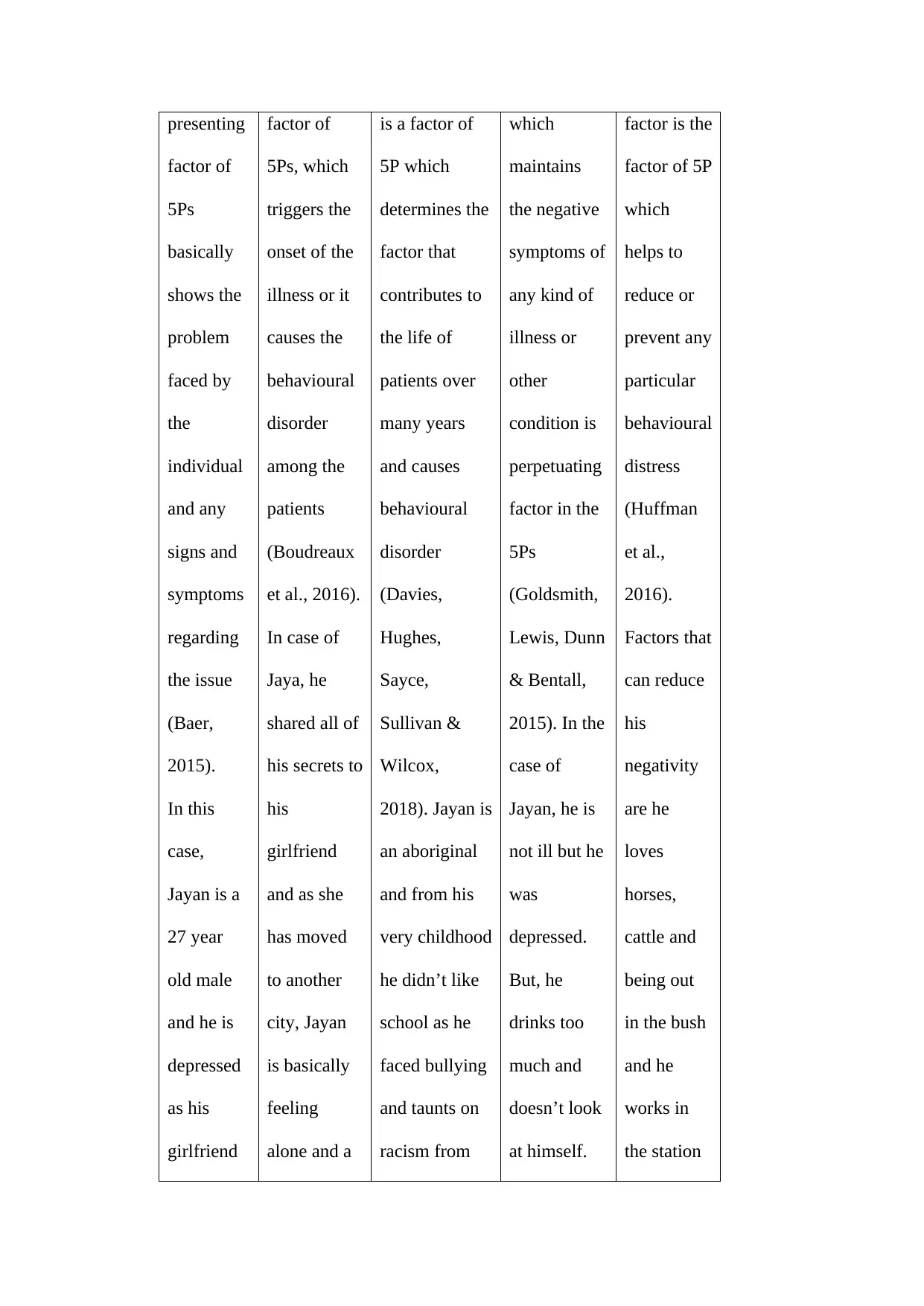
presenting
factor of
5Ps
basically
shows the
problem
faced by
the
individual
and any
signs and
symptoms
regarding
the issue
(Baer,
2015).
In this
case,
Jayan is a
27 year
old male
and he is
depressed
as his
girlfriend
factor of
5Ps, which
triggers the
onset of the
illness or it
causes the
behavioural
disorder
among the
patients
(Boudreaux
et al., 2016).
In case of
Jaya, he
shared all of
his secrets to
his
girlfriend
and as she
has moved
to another
city, Jayan
is basically
feeling
alone and a
is a factor of
5P which
determines the
factor that
contributes to
the life of
patients over
many years
and causes
behavioural
disorder
(Davies,
Hughes,
Sayce,
Sullivan &
Wilcox,
2018). Jayan is
an aboriginal
and from his
very childhood
he didn’t like
school as he
faced bullying
and taunts on
racism from
which
maintains
the negative
symptoms of
any kind of
illness or
other
condition is
perpetuating
factor in the
5Ps
(Goldsmith,
Lewis, Dunn
& Bentall,
2015). In the
case of
Jayan, he is
not ill but he
was
depressed.
But, he
drinks too
much and
doesn’t look
at himself.
factor is the
factor of 5P
which
helps to
reduce or
prevent any
particular
behavioural
distress
(Huffman
et al.,
2016).
Factors that
can reduce
his
negativity
are he
loves
horses,
cattle and
being out
in the bush
and he
works in
the station
factor of
5Ps
basically
shows the
problem
faced by
the
individual
and any
signs and
symptoms
regarding
the issue
(Baer,
2015).
In this
case,
Jayan is a
27 year
old male
and he is
depressed
as his
girlfriend
factor of
5Ps, which
triggers the
onset of the
illness or it
causes the
behavioural
disorder
among the
patients
(Boudreaux
et al., 2016).
In case of
Jaya, he
shared all of
his secrets to
his
girlfriend
and as she
has moved
to another
city, Jayan
is basically
feeling
alone and a
is a factor of
5P which
determines the
factor that
contributes to
the life of
patients over
many years
and causes
behavioural
disorder
(Davies,
Hughes,
Sayce,
Sullivan &
Wilcox,
2018). Jayan is
an aboriginal
and from his
very childhood
he didn’t like
school as he
faced bullying
and taunts on
racism from
which
maintains
the negative
symptoms of
any kind of
illness or
other
condition is
perpetuating
factor in the
5Ps
(Goldsmith,
Lewis, Dunn
& Bentall,
2015). In the
case of
Jayan, he is
not ill but he
was
depressed.
But, he
drinks too
much and
doesn’t look
at himself.
factor is the
factor of 5P
which
helps to
reduce or
prevent any
particular
behavioural
distress
(Huffman
et al.,
2016).
Factors that
can reduce
his
negativity
are he
loves
horses,
cattle and
being out
in the bush
and he
works in
the station
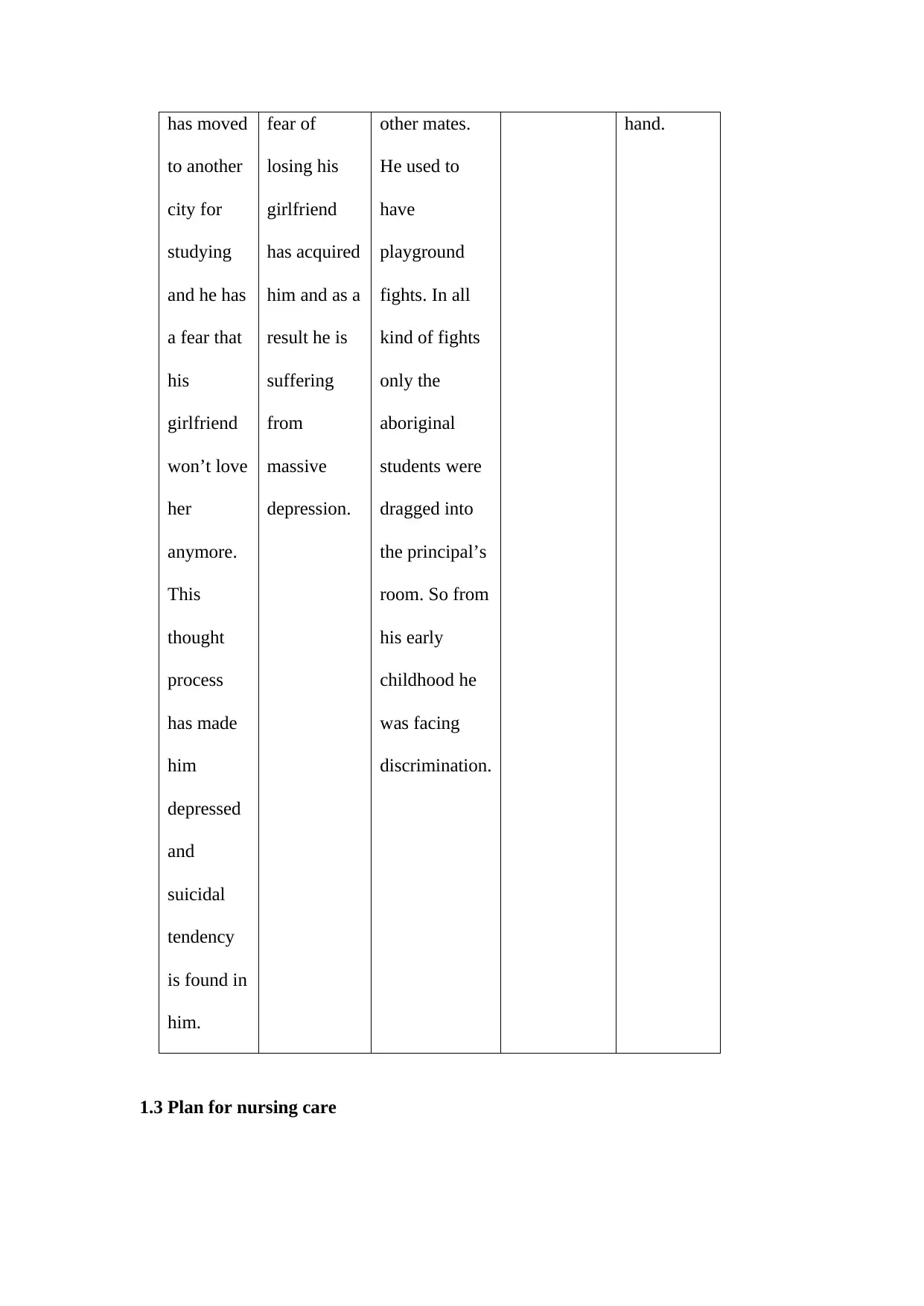
has moved
to another
city for
studying
and he has
a fear that
his
girlfriend
won’t love
her
anymore.
This
thought
process
has made
him
depressed
and
suicidal
tendency
is found in
him.
fear of
losing his
girlfriend
has acquired
him and as a
result he is
suffering
from
massive
depression.
other mates.
He used to
have
playground
fights. In all
kind of fights
only the
aboriginal
students were
dragged into
the principal’s
room. So from
his early
childhood he
was facing
discrimination.
hand.
1.3 Plan for nursing care
to another
city for
studying
and he has
a fear that
his
girlfriend
won’t love
her
anymore.
This
thought
process
has made
him
depressed
and
suicidal
tendency
is found in
him.
fear of
losing his
girlfriend
has acquired
him and as a
result he is
suffering
from
massive
depression.
other mates.
He used to
have
playground
fights. In all
kind of fights
only the
aboriginal
students were
dragged into
the principal’s
room. So from
his early
childhood he
was facing
discrimination.
hand.
1.3 Plan for nursing care
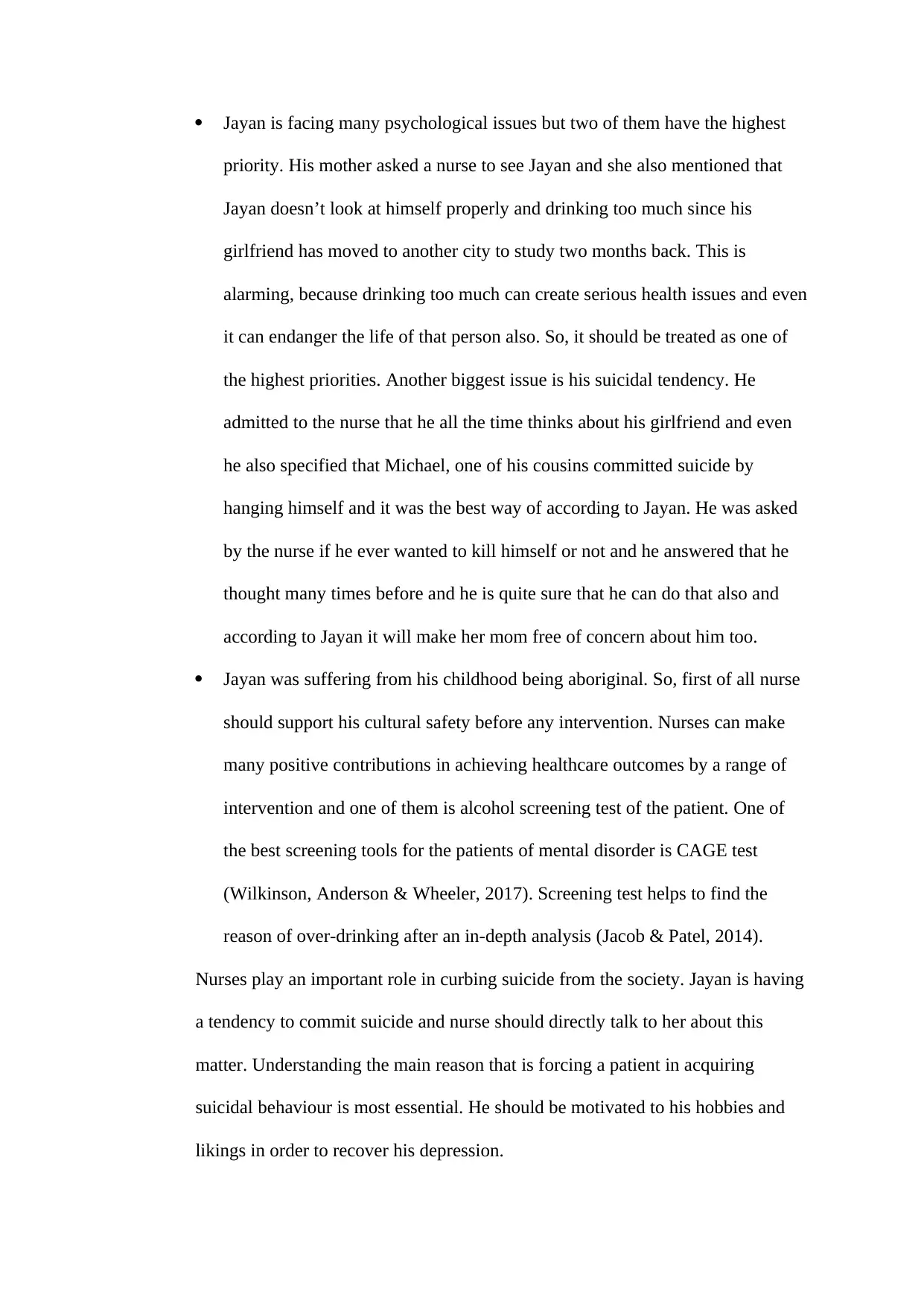
Jayan is facing many psychological issues but two of them have the highest
priority. His mother asked a nurse to see Jayan and she also mentioned that
Jayan doesn’t look at himself properly and drinking too much since his
girlfriend has moved to another city to study two months back. This is
alarming, because drinking too much can create serious health issues and even
it can endanger the life of that person also. So, it should be treated as one of
the highest priorities. Another biggest issue is his suicidal tendency. He
admitted to the nurse that he all the time thinks about his girlfriend and even
he also specified that Michael, one of his cousins committed suicide by
hanging himself and it was the best way of according to Jayan. He was asked
by the nurse if he ever wanted to kill himself or not and he answered that he
thought many times before and he is quite sure that he can do that also and
according to Jayan it will make her mom free of concern about him too.
Jayan was suffering from his childhood being aboriginal. So, first of all nurse
should support his cultural safety before any intervention. Nurses can make
many positive contributions in achieving healthcare outcomes by a range of
intervention and one of them is alcohol screening test of the patient. One of
the best screening tools for the patients of mental disorder is CAGE test
(Wilkinson, Anderson & Wheeler, 2017). Screening test helps to find the
reason of over-drinking after an in-depth analysis (Jacob & Patel, 2014).
Nurses play an important role in curbing suicide from the society. Jayan is having
a tendency to commit suicide and nurse should directly talk to her about this
matter. Understanding the main reason that is forcing a patient in acquiring
suicidal behaviour is most essential. He should be motivated to his hobbies and
likings in order to recover his depression.
priority. His mother asked a nurse to see Jayan and she also mentioned that
Jayan doesn’t look at himself properly and drinking too much since his
girlfriend has moved to another city to study two months back. This is
alarming, because drinking too much can create serious health issues and even
it can endanger the life of that person also. So, it should be treated as one of
the highest priorities. Another biggest issue is his suicidal tendency. He
admitted to the nurse that he all the time thinks about his girlfriend and even
he also specified that Michael, one of his cousins committed suicide by
hanging himself and it was the best way of according to Jayan. He was asked
by the nurse if he ever wanted to kill himself or not and he answered that he
thought many times before and he is quite sure that he can do that also and
according to Jayan it will make her mom free of concern about him too.
Jayan was suffering from his childhood being aboriginal. So, first of all nurse
should support his cultural safety before any intervention. Nurses can make
many positive contributions in achieving healthcare outcomes by a range of
intervention and one of them is alcohol screening test of the patient. One of
the best screening tools for the patients of mental disorder is CAGE test
(Wilkinson, Anderson & Wheeler, 2017). Screening test helps to find the
reason of over-drinking after an in-depth analysis (Jacob & Patel, 2014).
Nurses play an important role in curbing suicide from the society. Jayan is having
a tendency to commit suicide and nurse should directly talk to her about this
matter. Understanding the main reason that is forcing a patient in acquiring
suicidal behaviour is most essential. He should be motivated to his hobbies and
likings in order to recover his depression.
Secure Best Marks with AI Grader
Need help grading? Try our AI Grader for instant feedback on your assignments.
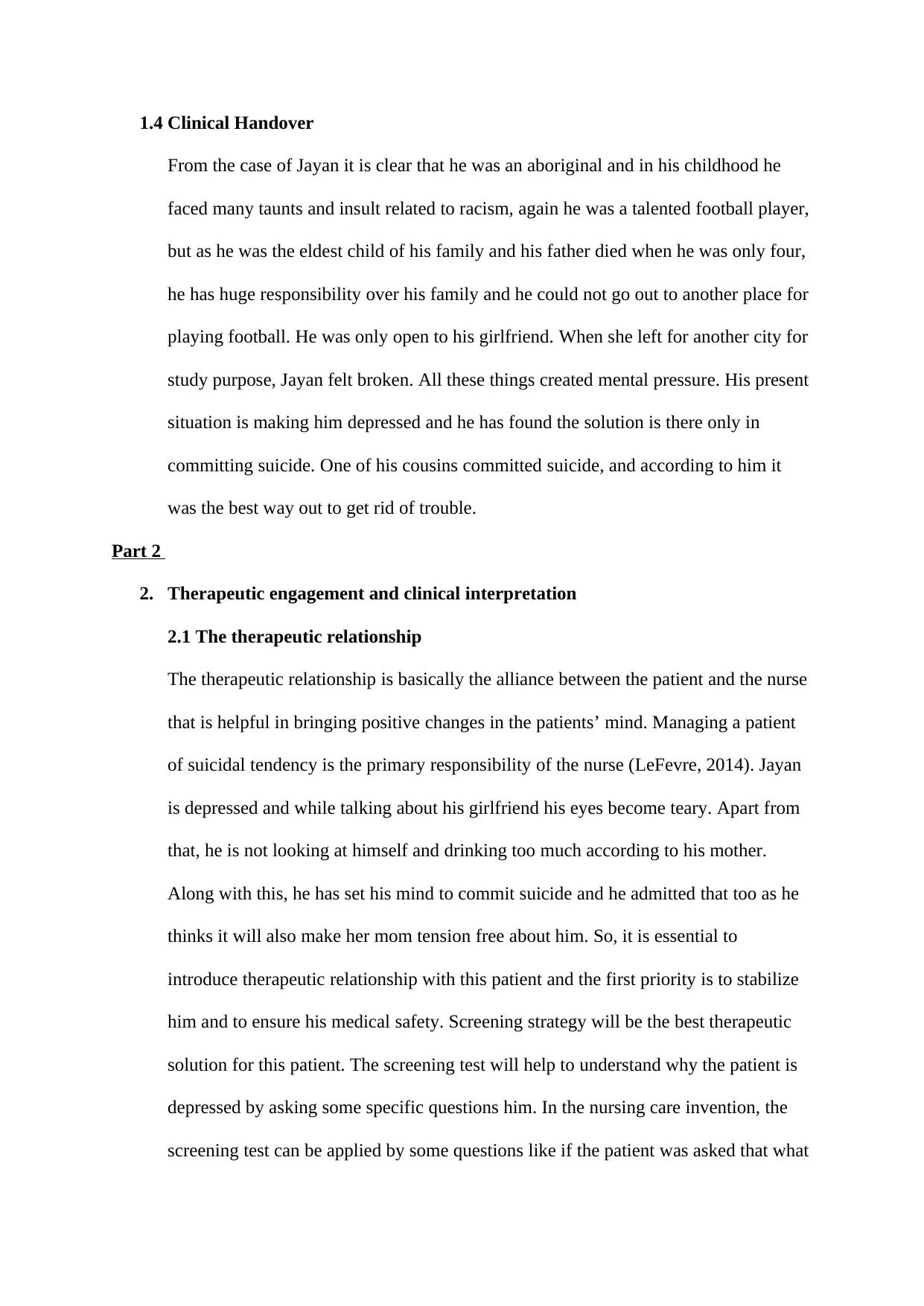
1.4 Clinical Handover
From the case of Jayan it is clear that he was an aboriginal and in his childhood he
faced many taunts and insult related to racism, again he was a talented football player,
but as he was the eldest child of his family and his father died when he was only four,
he has huge responsibility over his family and he could not go out to another place for
playing football. He was only open to his girlfriend. When she left for another city for
study purpose, Jayan felt broken. All these things created mental pressure. His present
situation is making him depressed and he has found the solution is there only in
committing suicide. One of his cousins committed suicide, and according to him it
was the best way out to get rid of trouble.
Part 2
2. Therapeutic engagement and clinical interpretation
2.1 The therapeutic relationship
The therapeutic relationship is basically the alliance between the patient and the nurse
that is helpful in bringing positive changes in the patients’ mind. Managing a patient
of suicidal tendency is the primary responsibility of the nurse (LeFevre, 2014). Jayan
is depressed and while talking about his girlfriend his eyes become teary. Apart from
that, he is not looking at himself and drinking too much according to his mother.
Along with this, he has set his mind to commit suicide and he admitted that too as he
thinks it will also make her mom tension free about him. So, it is essential to
introduce therapeutic relationship with this patient and the first priority is to stabilize
him and to ensure his medical safety. Screening strategy will be the best therapeutic
solution for this patient. The screening test will help to understand why the patient is
depressed by asking some specific questions him. In the nursing care invention, the
screening test can be applied by some questions like if the patient was asked that what
From the case of Jayan it is clear that he was an aboriginal and in his childhood he
faced many taunts and insult related to racism, again he was a talented football player,
but as he was the eldest child of his family and his father died when he was only four,
he has huge responsibility over his family and he could not go out to another place for
playing football. He was only open to his girlfriend. When she left for another city for
study purpose, Jayan felt broken. All these things created mental pressure. His present
situation is making him depressed and he has found the solution is there only in
committing suicide. One of his cousins committed suicide, and according to him it
was the best way out to get rid of trouble.
Part 2
2. Therapeutic engagement and clinical interpretation
2.1 The therapeutic relationship
The therapeutic relationship is basically the alliance between the patient and the nurse
that is helpful in bringing positive changes in the patients’ mind. Managing a patient
of suicidal tendency is the primary responsibility of the nurse (LeFevre, 2014). Jayan
is depressed and while talking about his girlfriend his eyes become teary. Apart from
that, he is not looking at himself and drinking too much according to his mother.
Along with this, he has set his mind to commit suicide and he admitted that too as he
thinks it will also make her mom tension free about him. So, it is essential to
introduce therapeutic relationship with this patient and the first priority is to stabilize
him and to ensure his medical safety. Screening strategy will be the best therapeutic
solution for this patient. The screening test will help to understand why the patient is
depressed by asking some specific questions him. In the nursing care invention, the
screening test can be applied by some questions like if the patient was asked that what
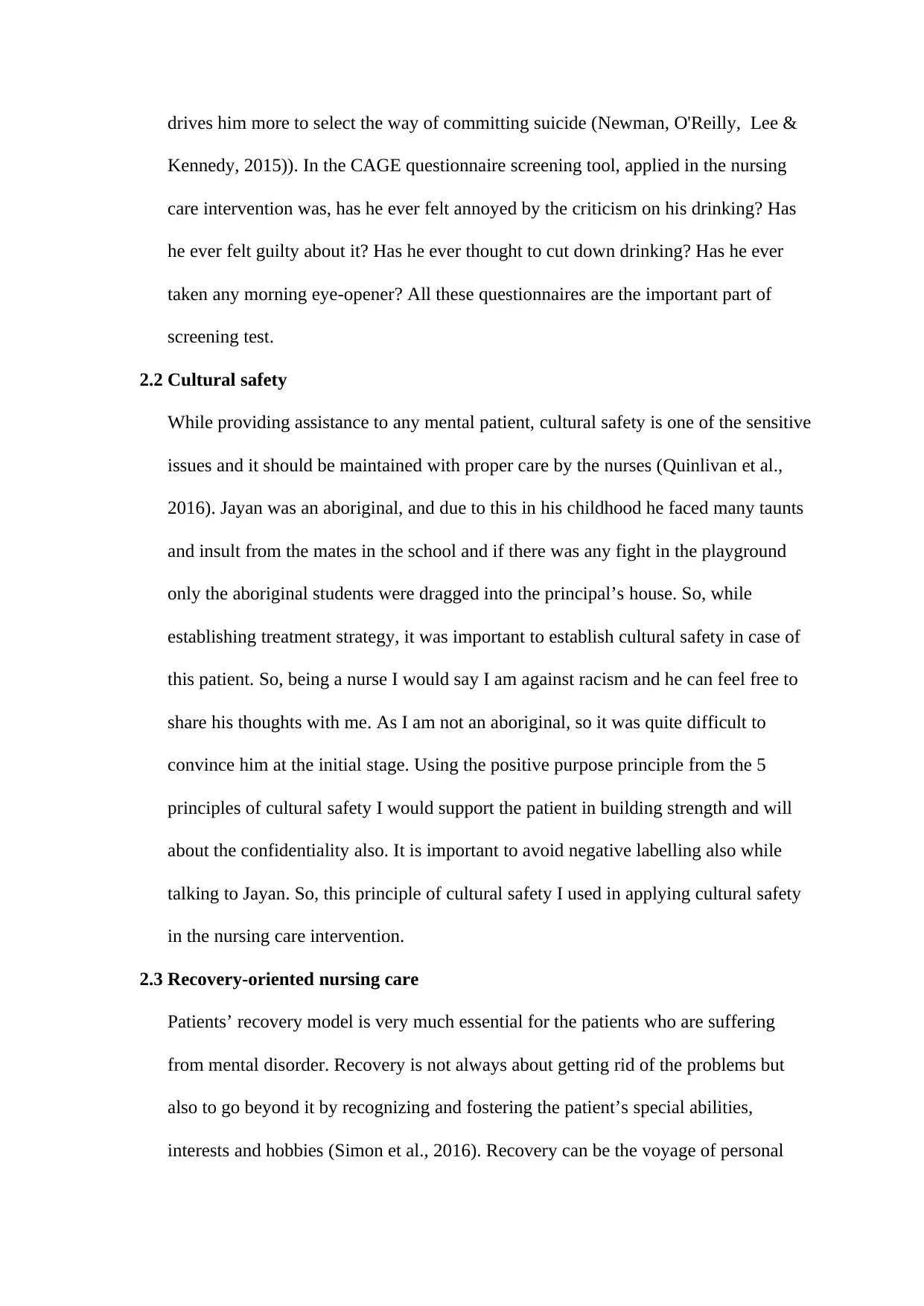
drives him more to select the way of committing suicide (Newman, O'Reilly, Lee &
Kennedy, 2015)). In the CAGE questionnaire screening tool, applied in the nursing
care intervention was, has he ever felt annoyed by the criticism on his drinking? Has
he ever felt guilty about it? Has he ever thought to cut down drinking? Has he ever
taken any morning eye-opener? All these questionnaires are the important part of
screening test.
2.2 Cultural safety
While providing assistance to any mental patient, cultural safety is one of the sensitive
issues and it should be maintained with proper care by the nurses (Quinlivan et al.,
2016). Jayan was an aboriginal, and due to this in his childhood he faced many taunts
and insult from the mates in the school and if there was any fight in the playground
only the aboriginal students were dragged into the principal’s house. So, while
establishing treatment strategy, it was important to establish cultural safety in case of
this patient. So, being a nurse I would say I am against racism and he can feel free to
share his thoughts with me. As I am not an aboriginal, so it was quite difficult to
convince him at the initial stage. Using the positive purpose principle from the 5
principles of cultural safety I would support the patient in building strength and will
about the confidentiality also. It is important to avoid negative labelling also while
talking to Jayan. So, this principle of cultural safety I used in applying cultural safety
in the nursing care intervention.
2.3 Recovery-oriented nursing care
Patients’ recovery model is very much essential for the patients who are suffering
from mental disorder. Recovery is not always about getting rid of the problems but
also to go beyond it by recognizing and fostering the patient’s special abilities,
interests and hobbies (Simon et al., 2016). Recovery can be the voyage of personal
Kennedy, 2015)). In the CAGE questionnaire screening tool, applied in the nursing
care intervention was, has he ever felt annoyed by the criticism on his drinking? Has
he ever felt guilty about it? Has he ever thought to cut down drinking? Has he ever
taken any morning eye-opener? All these questionnaires are the important part of
screening test.
2.2 Cultural safety
While providing assistance to any mental patient, cultural safety is one of the sensitive
issues and it should be maintained with proper care by the nurses (Quinlivan et al.,
2016). Jayan was an aboriginal, and due to this in his childhood he faced many taunts
and insult from the mates in the school and if there was any fight in the playground
only the aboriginal students were dragged into the principal’s house. So, while
establishing treatment strategy, it was important to establish cultural safety in case of
this patient. So, being a nurse I would say I am against racism and he can feel free to
share his thoughts with me. As I am not an aboriginal, so it was quite difficult to
convince him at the initial stage. Using the positive purpose principle from the 5
principles of cultural safety I would support the patient in building strength and will
about the confidentiality also. It is important to avoid negative labelling also while
talking to Jayan. So, this principle of cultural safety I used in applying cultural safety
in the nursing care intervention.
2.3 Recovery-oriented nursing care
Patients’ recovery model is very much essential for the patients who are suffering
from mental disorder. Recovery is not always about getting rid of the problems but
also to go beyond it by recognizing and fostering the patient’s special abilities,
interests and hobbies (Simon et al., 2016). Recovery can be the voyage of personal
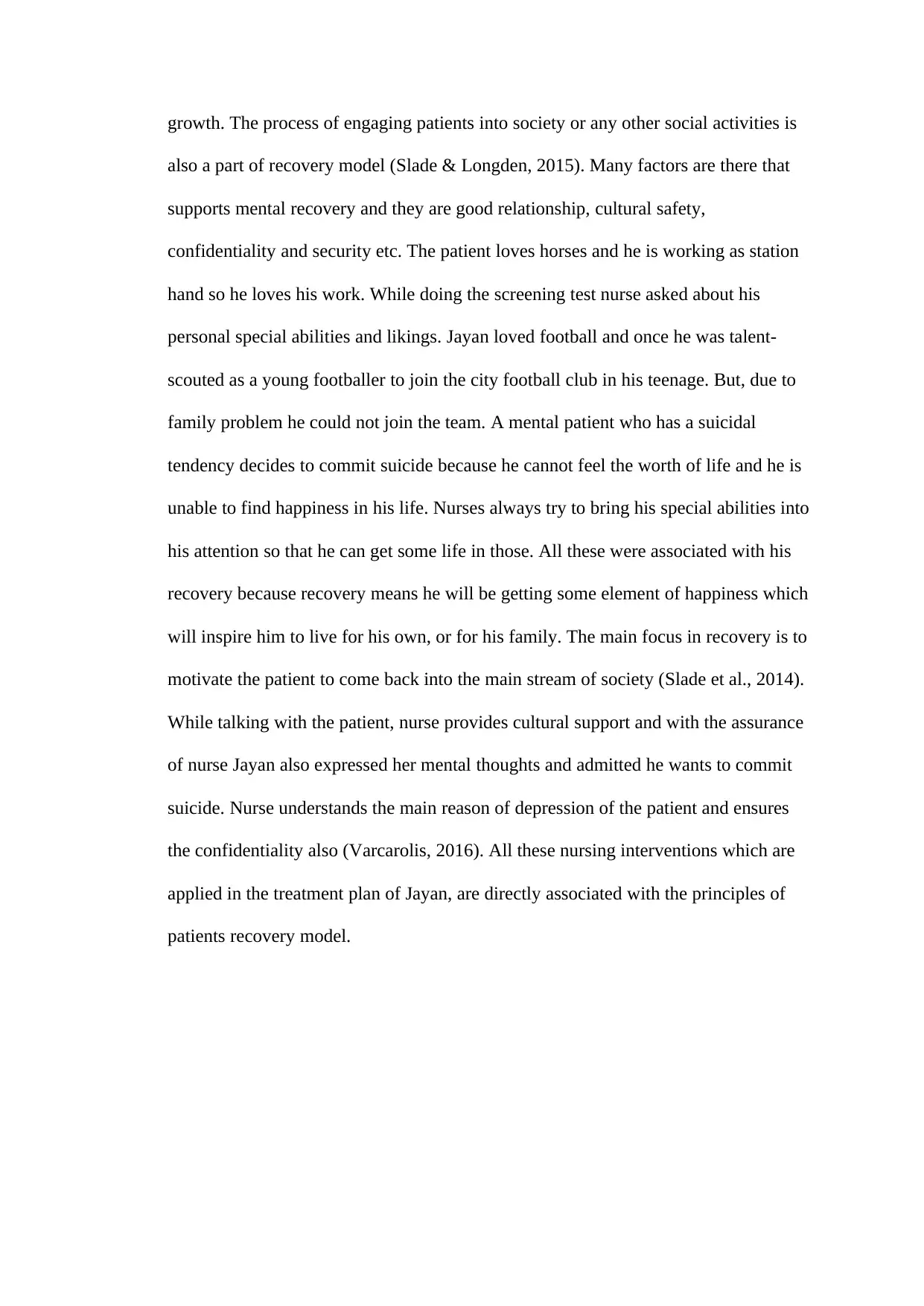
growth. The process of engaging patients into society or any other social activities is
also a part of recovery model (Slade & Longden, 2015). Many factors are there that
supports mental recovery and they are good relationship, cultural safety,
confidentiality and security etc. The patient loves horses and he is working as station
hand so he loves his work. While doing the screening test nurse asked about his
personal special abilities and likings. Jayan loved football and once he was talent-
scouted as a young footballer to join the city football club in his teenage. But, due to
family problem he could not join the team. A mental patient who has a suicidal
tendency decides to commit suicide because he cannot feel the worth of life and he is
unable to find happiness in his life. Nurses always try to bring his special abilities into
his attention so that he can get some life in those. All these were associated with his
recovery because recovery means he will be getting some element of happiness which
will inspire him to live for his own, or for his family. The main focus in recovery is to
motivate the patient to come back into the main stream of society (Slade et al., 2014).
While talking with the patient, nurse provides cultural support and with the assurance
of nurse Jayan also expressed her mental thoughts and admitted he wants to commit
suicide. Nurse understands the main reason of depression of the patient and ensures
the confidentiality also (Varcarolis, 2016). All these nursing interventions which are
applied in the treatment plan of Jayan, are directly associated with the principles of
patients recovery model.
also a part of recovery model (Slade & Longden, 2015). Many factors are there that
supports mental recovery and they are good relationship, cultural safety,
confidentiality and security etc. The patient loves horses and he is working as station
hand so he loves his work. While doing the screening test nurse asked about his
personal special abilities and likings. Jayan loved football and once he was talent-
scouted as a young footballer to join the city football club in his teenage. But, due to
family problem he could not join the team. A mental patient who has a suicidal
tendency decides to commit suicide because he cannot feel the worth of life and he is
unable to find happiness in his life. Nurses always try to bring his special abilities into
his attention so that he can get some life in those. All these were associated with his
recovery because recovery means he will be getting some element of happiness which
will inspire him to live for his own, or for his family. The main focus in recovery is to
motivate the patient to come back into the main stream of society (Slade et al., 2014).
While talking with the patient, nurse provides cultural support and with the assurance
of nurse Jayan also expressed her mental thoughts and admitted he wants to commit
suicide. Nurse understands the main reason of depression of the patient and ensures
the confidentiality also (Varcarolis, 2016). All these nursing interventions which are
applied in the treatment plan of Jayan, are directly associated with the principles of
patients recovery model.
Paraphrase This Document
Need a fresh take? Get an instant paraphrase of this document with our AI Paraphraser
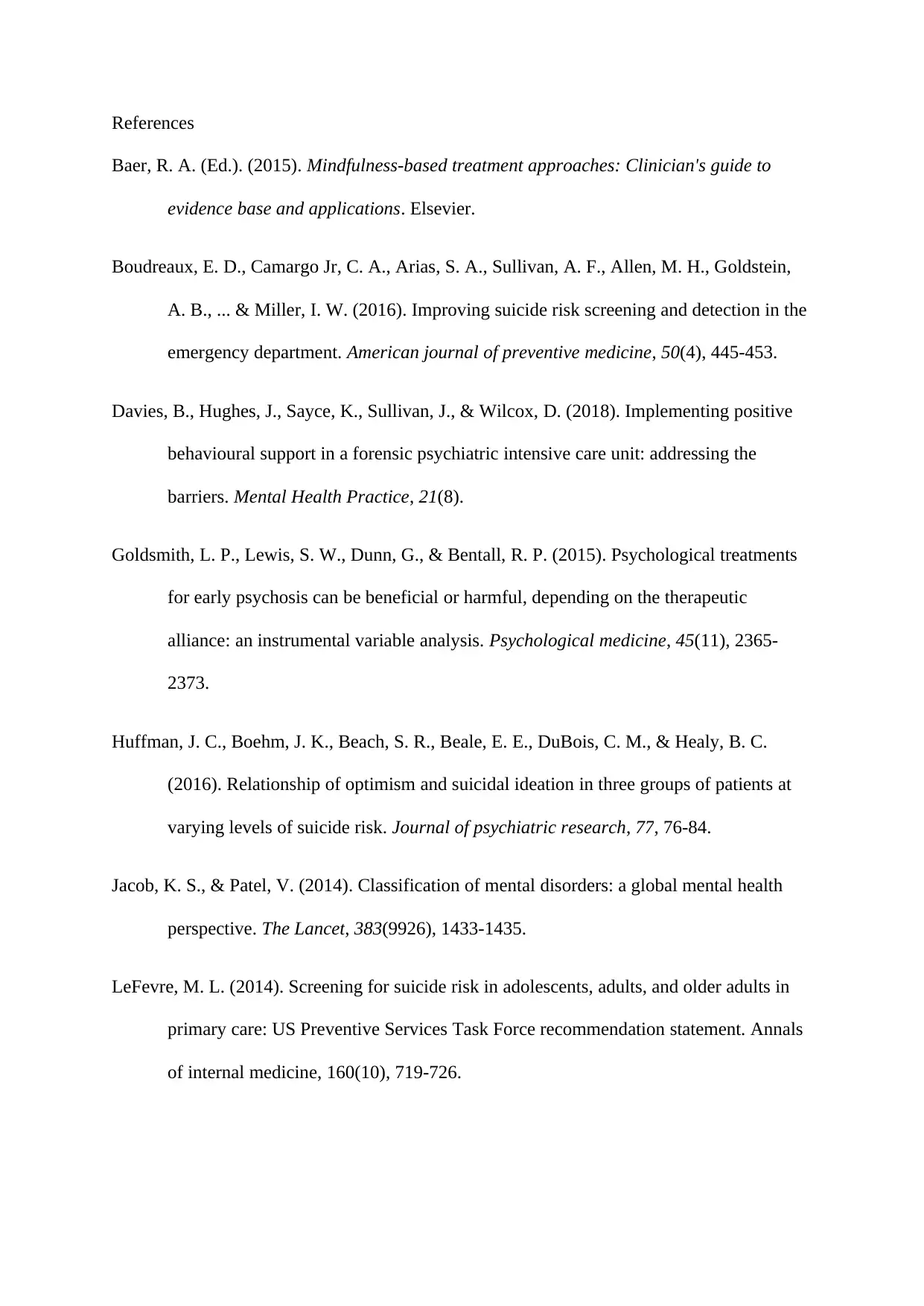
References
Baer, R. A. (Ed.). (2015). Mindfulness-based treatment approaches: Clinician's guide to
evidence base and applications. Elsevier.
Boudreaux, E. D., Camargo Jr, C. A., Arias, S. A., Sullivan, A. F., Allen, M. H., Goldstein,
A. B., ... & Miller, I. W. (2016). Improving suicide risk screening and detection in the
emergency department. American journal of preventive medicine, 50(4), 445-453.
Davies, B., Hughes, J., Sayce, K., Sullivan, J., & Wilcox, D. (2018). Implementing positive
behavioural support in a forensic psychiatric intensive care unit: addressing the
barriers. Mental Health Practice, 21(8).
Goldsmith, L. P., Lewis, S. W., Dunn, G., & Bentall, R. P. (2015). Psychological treatments
for early psychosis can be beneficial or harmful, depending on the therapeutic
alliance: an instrumental variable analysis. Psychological medicine, 45(11), 2365-
2373.
Huffman, J. C., Boehm, J. K., Beach, S. R., Beale, E. E., DuBois, C. M., & Healy, B. C.
(2016). Relationship of optimism and suicidal ideation in three groups of patients at
varying levels of suicide risk. Journal of psychiatric research, 77, 76-84.
Jacob, K. S., & Patel, V. (2014). Classification of mental disorders: a global mental health
perspective. The Lancet, 383(9926), 1433-1435.
LeFevre, M. L. (2014). Screening for suicide risk in adolescents, adults, and older adults in
primary care: US Preventive Services Task Force recommendation statement. Annals
of internal medicine, 160(10), 719-726.
Baer, R. A. (Ed.). (2015). Mindfulness-based treatment approaches: Clinician's guide to
evidence base and applications. Elsevier.
Boudreaux, E. D., Camargo Jr, C. A., Arias, S. A., Sullivan, A. F., Allen, M. H., Goldstein,
A. B., ... & Miller, I. W. (2016). Improving suicide risk screening and detection in the
emergency department. American journal of preventive medicine, 50(4), 445-453.
Davies, B., Hughes, J., Sayce, K., Sullivan, J., & Wilcox, D. (2018). Implementing positive
behavioural support in a forensic psychiatric intensive care unit: addressing the
barriers. Mental Health Practice, 21(8).
Goldsmith, L. P., Lewis, S. W., Dunn, G., & Bentall, R. P. (2015). Psychological treatments
for early psychosis can be beneficial or harmful, depending on the therapeutic
alliance: an instrumental variable analysis. Psychological medicine, 45(11), 2365-
2373.
Huffman, J. C., Boehm, J. K., Beach, S. R., Beale, E. E., DuBois, C. M., & Healy, B. C.
(2016). Relationship of optimism and suicidal ideation in three groups of patients at
varying levels of suicide risk. Journal of psychiatric research, 77, 76-84.
Jacob, K. S., & Patel, V. (2014). Classification of mental disorders: a global mental health
perspective. The Lancet, 383(9926), 1433-1435.
LeFevre, M. L. (2014). Screening for suicide risk in adolescents, adults, and older adults in
primary care: US Preventive Services Task Force recommendation statement. Annals
of internal medicine, 160(10), 719-726.
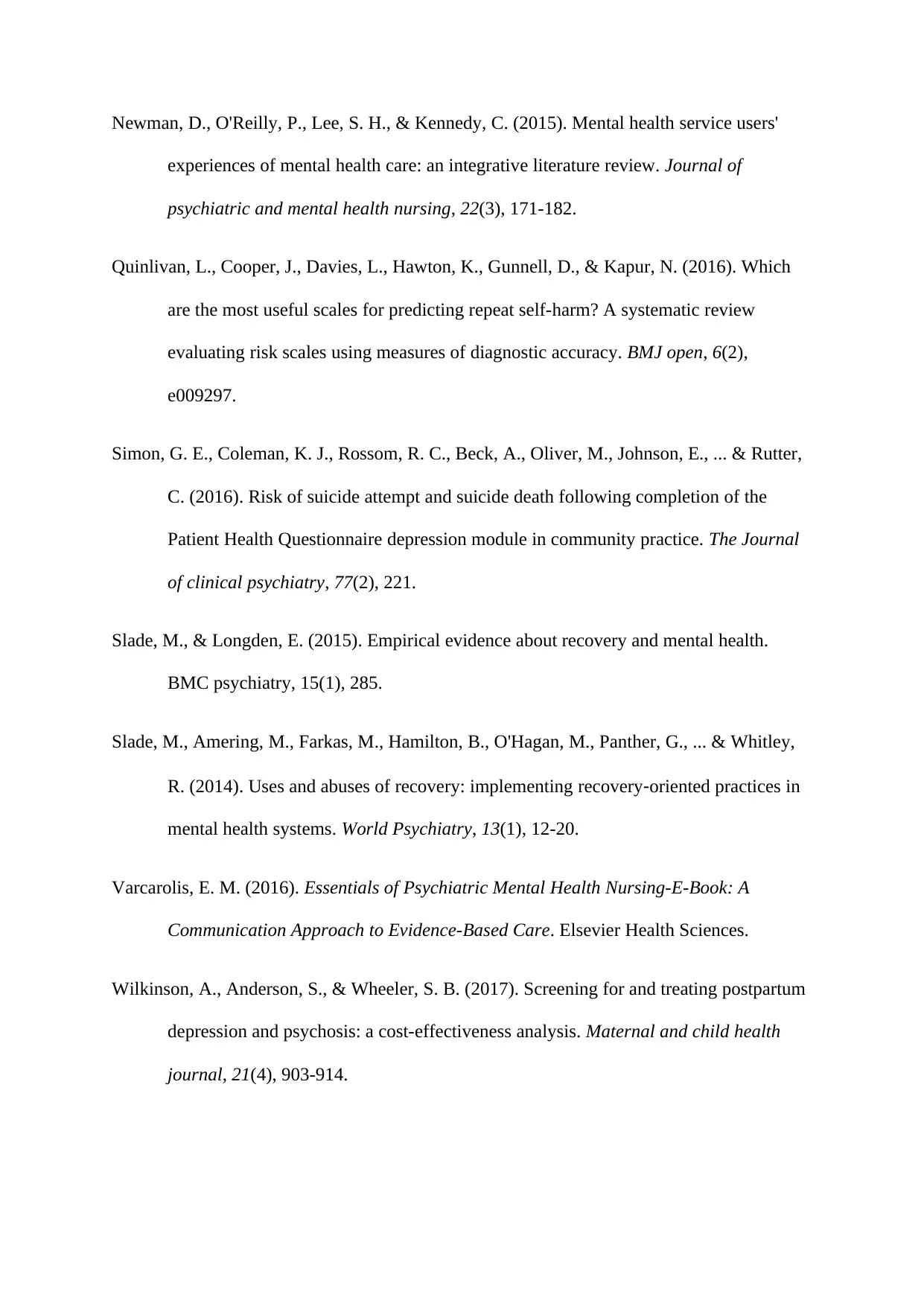
Newman, D., O'Reilly, P., Lee, S. H., & Kennedy, C. (2015). Mental health service users'
experiences of mental health care: an integrative literature review. Journal of
psychiatric and mental health nursing, 22(3), 171-182.
Quinlivan, L., Cooper, J., Davies, L., Hawton, K., Gunnell, D., & Kapur, N. (2016). Which
are the most useful scales for predicting repeat self-harm? A systematic review
evaluating risk scales using measures of diagnostic accuracy. BMJ open, 6(2),
e009297.
Simon, G. E., Coleman, K. J., Rossom, R. C., Beck, A., Oliver, M., Johnson, E., ... & Rutter,
C. (2016). Risk of suicide attempt and suicide death following completion of the
Patient Health Questionnaire depression module in community practice. The Journal
of clinical psychiatry, 77(2), 221.
Slade, M., & Longden, E. (2015). Empirical evidence about recovery and mental health.
BMC psychiatry, 15(1), 285.
Slade, M., Amering, M., Farkas, M., Hamilton, B., O'Hagan, M., Panther, G., ... & Whitley,
R. (2014). Uses and abuses of recovery: implementing recovery‐oriented practices in
mental health systems. World Psychiatry, 13(1), 12-20.
Varcarolis, E. M. (2016). Essentials of Psychiatric Mental Health Nursing-E-Book: A
Communication Approach to Evidence-Based Care. Elsevier Health Sciences.
Wilkinson, A., Anderson, S., & Wheeler, S. B. (2017). Screening for and treating postpartum
depression and psychosis: a cost-effectiveness analysis. Maternal and child health
journal, 21(4), 903-914.
experiences of mental health care: an integrative literature review. Journal of
psychiatric and mental health nursing, 22(3), 171-182.
Quinlivan, L., Cooper, J., Davies, L., Hawton, K., Gunnell, D., & Kapur, N. (2016). Which
are the most useful scales for predicting repeat self-harm? A systematic review
evaluating risk scales using measures of diagnostic accuracy. BMJ open, 6(2),
e009297.
Simon, G. E., Coleman, K. J., Rossom, R. C., Beck, A., Oliver, M., Johnson, E., ... & Rutter,
C. (2016). Risk of suicide attempt and suicide death following completion of the
Patient Health Questionnaire depression module in community practice. The Journal
of clinical psychiatry, 77(2), 221.
Slade, M., & Longden, E. (2015). Empirical evidence about recovery and mental health.
BMC psychiatry, 15(1), 285.
Slade, M., Amering, M., Farkas, M., Hamilton, B., O'Hagan, M., Panther, G., ... & Whitley,
R. (2014). Uses and abuses of recovery: implementing recovery‐oriented practices in
mental health systems. World Psychiatry, 13(1), 12-20.
Varcarolis, E. M. (2016). Essentials of Psychiatric Mental Health Nursing-E-Book: A
Communication Approach to Evidence-Based Care. Elsevier Health Sciences.
Wilkinson, A., Anderson, S., & Wheeler, S. B. (2017). Screening for and treating postpartum
depression and psychosis: a cost-effectiveness analysis. Maternal and child health
journal, 21(4), 903-914.

1 out of 10
Your All-in-One AI-Powered Toolkit for Academic Success.
+13062052269
info@desklib.com
Available 24*7 on WhatsApp / Email
![[object Object]](/_next/static/media/star-bottom.7253800d.svg)
Unlock your academic potential
© 2024 | Zucol Services PVT LTD | All rights reserved.


